Pilgrimage to West Grinstead, Aylesford & Ramsgate
Church and Shrine of Our Lady at West Grinstead
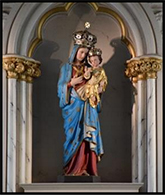
Ten pilgrims from three different Island parishes set off by minibus for Ramsgate and Canterbury on September 9th. The first stop was at the Church and Shrine of Our Lady of Consolation, West Grinstead.
This was an important centre for the Church during penal times. The faith was never lost thanks largely to the Caryll family who were a wealthy landowning Sussex family who built the “priest’s house”, (now the presbytery) in the mid 16th century. During penal times most priests who secretly returned to England from abroad, headed for this West Grinstead House, ideally situated deep in the wooded area of West Sussex. Our own two Island martyrs, Blessed Robert Anderton and Blessed William Marsden, were probably heading for West Grinstead when they were caught and executed in 1586.
The end of the penal days brought an obvious end to the secrecy surrounding the place and the present magnificent church was built in 1876. At the same time a statue of Our Lady at W. Grinstead was crowned by the Papal Delegate, representing Pope Leo XIII. This solemn crowning at the shrine in the Sussex countryside, in thanksgiving for the preservation of the faith in penal times, was the first such crowning since the Reformation.
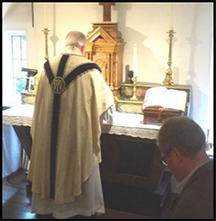
The present Shrine of Our Lady was erected in 1882 in thanksgiving for the preservation of the faith and the important role that W. Grinstead played in penal times.
After a talk on the history (and the future) of the shrine, Fr. Jonathan offered a Votive Mass of Our Lady (picture – above) in the upstairs recusant chapel, where priests (ordained abroad in secret) have at one time offered the same Mass that we have today. This Mass was offered for the eternal repose of the soul of Fr. David Goddard, the shrine administrator, who died in 2018. In his sermon he reminded us of the historic nature of this tiny chapel and of the significance of Our Blessed Lady. “It is poignant that we begin this pilgrimage with this Votive Mass of Our Lady, the day after the Feast of her Nativity ..,. and that we conclude the pilgrimage on the Feast of the Holy Name of Mary on Thursday. We pray that Mary will intercede for us and draw us closer to her Son, Jesus”.
Aylesford Priory
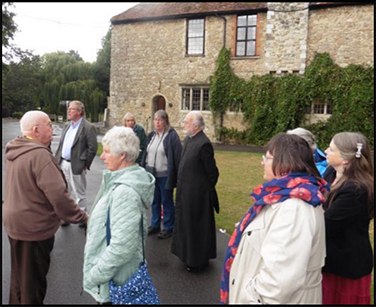
After lunch at West Grinstead, it was on to Aylesford Priory in Kent, where pilgrims were given a guided tour by a Carmelite priest, Fr. David (picture – above).
He explained the significance of the architecture of the priory buildings and its evolution as a pilgrimage centre.
In 1242 a group of hermits from Mount Carmel were given this site to establish a community by a crusader returning from the Holy Land.
The hermits later adopted the lifestyle of mendicant friars at the service of Church and society. The priory passed from Carmelite ownership into private hands at the Reformation in 1538, becoming known as “The Friars”.
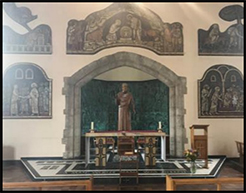
Aylesford was purchased back by the Carmelite Order in 1949 when Mass was celebrated once again and, in the words of the first prior of the restored community, Fr. Malachy Lynch, “Catholic life returned”!
Today many of the medieval buildings have been restored and a new open-air church has been built on the site of the medieval chapel.
The shrine at Aylesford is dedicated to Our Lady of the Assumption, and beautiful chapels dedicated to the saints of Carmel (notably St. Simon Stock) have been described as “prayers in stone”.
St. Augustine’s, Ramsgate
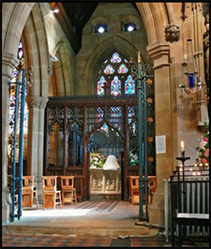
This is a fascinating and dramatic place. St Augustine’s is the personal project of the renowned architect Augustus Pugin, most famous for designing “Big Ben,” and his other work on the Houses of Parliament in Westminster, in the mid nineteenth century. He said that this building was the perfect model of his ‘true principles’ of architecture and called it “my own child.” A leader of the Gothic Revival, St Augustine’s was the only church Pugin built with his own money, and so unencumbered by the demands of patrons.
This is one of the finest gothic style churches in England.
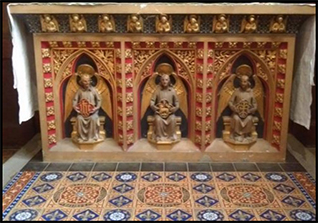
The original abbey was founded by St Augustine c. AD 597 and destroyed in 1538. St Augustine’s Church or the Shrine of St. Augustine of Canterbury was the personal church of Catholic architect, Augustus Pugin, the renowned nineteenth century architect, designer, and reformer. This altar (below) in St. Augustine’s is almost identical to the one that he designed in the Lady Chapel at St. Mary’s, Ryde.
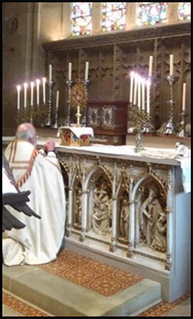
Having built his home (The Grange, Ramsgate, next door), Pugin began work on St Augustine’s in 1846 and worked on it until his death in 1852. His sons completed many of the designs. He died in 1852 and is buried in a vault beneath the chantry chapel he designed, alongside several members of his family.
It was good to meet up again with Fr. Christopher Basden (parish priest) and with Fr. Simon Heans (Shrine Administrator). Fr. Basden spoke to us on the history of the shrine and its unique (Pugin) architecture. The group spent time before the Blessed Sacrament during morning Exposition (picture – below), before Mass concelebrated by Fr. Simon Heans and Fr. Jonathan.
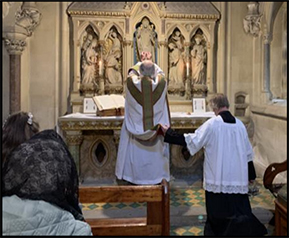
On Wednesday (11th September) the pilgrims arrived for Mass at St. John’s Chapel in St. Augustine’s. This was a Votive Mass (E.F.) of the Holy Angels offered by Fr. Jonathan. There was time for a final look around this historic church and to pray at the tomb of its founder, Augustus Pugin, buried in a side chapel on the south side of the nave.
St. Augustine’s Cross
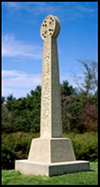
This cross was commissioned in 1884 by Granville George Leveson-Gower, 2nd Earl Granville. According to local legend, in AD 597 the first meeting was held between King Æthelberht and the monk Augustine, newly arrived from Rome.
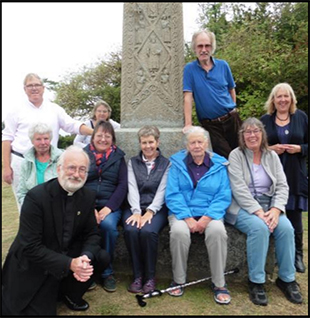
Augustine had recently landed on the Isle of Thanet, having been sent by Pope Gregory to convert the Anglo-Saxons to Christianity and thereby re-establish the faith in a country in which it had faded with the fall of the Roman Empire.
Tradition holds that Æhelberht was converted to Christianity and Augustine baptised him on Whit Sunday in AD 597. On Christmas Day of that year, according to a papal letter of AD 598, more than 10,000 baptisms were carried out.
The cross carries carvings illustrating the Christian story on its west side, which includes the Annunciation, the Virgin and Child, the Crucifixion and the Transfiguration.
Fr. Jonathan led prayers at the Cross, thanking God for the mission of St. Augustine to England.